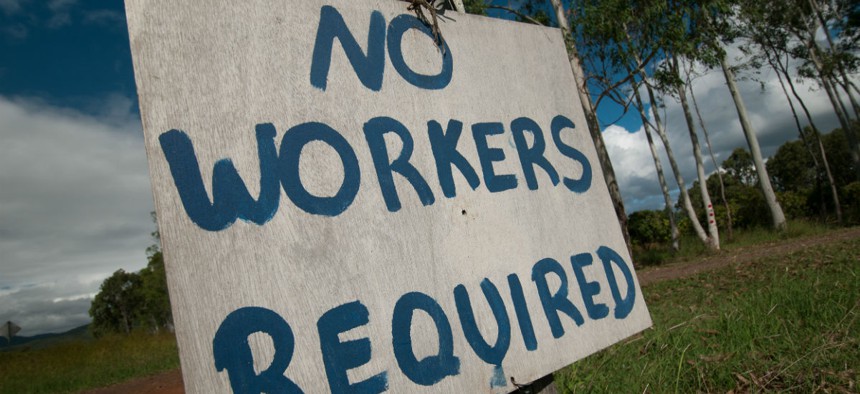Why Hiring Freezes Don’t Work
Shrinking the workforce through attrition is guaranteed only to produce a federal bureaucracy badly out of step with the government we want.
Team Trump rode into town determined to disrupt the federal government. One of the very first disrupters was a hiring freeze on federal employees, with a promise to reduce the size of government through attrition. That has certainly disrupted government—but it’s missed the chance for the real transformation that President Trump promised and that the federal government desperately needs.
The freeze is a clumsy tool aimed at the wrong problem. Lessons from past administrations (both Democratic and Republican) teach us that hiring freezes inevitably—and quickly—crack and thaw. Shrinking the workforce through attrition is guaranteed only to produce a federal bureaucracy badly out of step with the government we want.
Here’s why. There’s no such thing as “the federal bureaucracy.” In fact, the bureaucracy falls into four buckets.
First, there are the big-three entitlement programs: Social Security, Medicare, and Medicaid. They account for 51 percent of all federal spending, but the agencies managing them employ just over 3 percent of federal employees. If you freeze employees in this group, you lose leverage over vast sums of money and open the door to waste, fraud, and abuse. In fact, each employee in the Centers for Medicare and Medicaid Services, from the administrator to the receptionist, is responsible, on average, for more than $140 million in spending—each.
Second, there is a collection of big service programs, the 16 federal agencies most responsible for service to—and contact with—citizens. This includes the Federal Aviation Administration and the Transportation Security Administration to keep flyers safe and planes in the air. It includes Customs and Border Protection, Citizenship and Immigration Services, and Immigration and Customs Enforcement, to protect our borders and vet immigrants and refugees. There’s the FBI and the Bureau of Prisons to catch criminals and keep them off the streets. There’s a collection of agencies that make sure food and drugs are safe and defend us against Zika and Ebola (including the Food and Drug Administration, the Centers for Disease Control and Prevention and the National Institutes of Health). Add the Federal Emergency Management Administration, the National Park Service, the Indian Health Service and the Veterans Affairs Department, all of which perform vital services for citizens. Finally, there’s the Census Bureau, the one bureaucratic function mandated in the Constitution.
These agencies account for 41 percent of all federal employment and almost two-thirds of federal employees outside of the Defense Department, but just 8 percent of all federal spending. Cut them and we’d immediately feel the pain—longer lines that undermine airport security, porous borders that threaten the homeland, delayed care for vets who deserve our best.
The third bucket is Defense—one-third of all federal employees. Finally, there’s the fourth bucket—everything else, from our relations with other countries through the State Department to safeguarding our nuclear weapons in the Energy Department. That’s about one-fifth of all federal employees.
Nothing could be more clumsy than trying to manage all four buckets with just one broken-down mule—a hiring freeze followed by downsizing through attrition, something previous administrations have already proven can’t do the job. Washington is full of uncertainty these days, but we can be sure about how this would turn out: government wouldn’t have the people it needs for the jobs to be done. The news would be full of stories about angry citizens and wasted money.
This isn’t a case for circling the wagons around a government that badly needs reform. It’s a case for being smart instead of clumsy.
For decades, I’ve joined many of my colleagues who have argued that there’s no sense in trying to run government like the private sector. I give up. Let’s run government with the lessons that the private sector really teaches. Here’s a start:
First, focus on the customer experience. No 5-star hotel would stay in business long if a hiring freeze produced a short-staffed kitchen that served burned steaks and half-baked potatoes. The best private companies focus on providing the best customer experience. The federal government has a long way to go, but Forrester Research found glimmers of hope. The State Department’s Bureau of Consular Affairs, for example, in 2016 posted the second-biggest customer-satisfaction gain of any organization in the country, because its employees found smart new ways to improve passport processing. We know how to push government to private-sector standards by using private-sector strategies for people management.
Second, bring in technology. Customers have gotten used to booking reservations online and providing feedback through social media. A British think tank argues that governments there could save billions of pounds and shrink government by thousands of workers by implementing private-sector lessons about how to produce better experiences and value for taxpayer dollars.
So let’s run government more like the private sector. Let’s be smart on strategy, focus on improving how government connects with citizens, and bring in technology.
And let’s learn the most important private-sector lesson. We need disruption, but the right disruption comes not from targeting employees but by hiring the right ones, who can disrupt bureaucracies and drive innovation.
Donald F. Kettl is a professor and former dean of the University of Maryland School of Public Policy.




